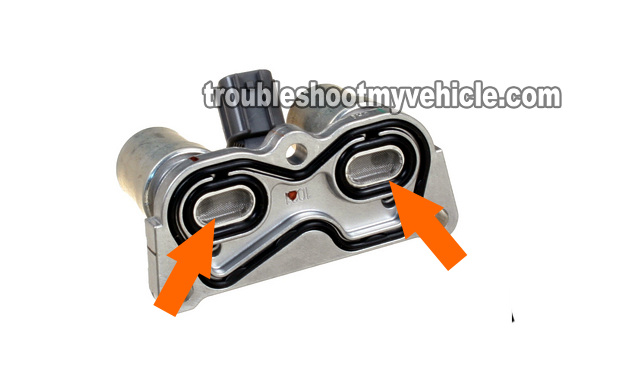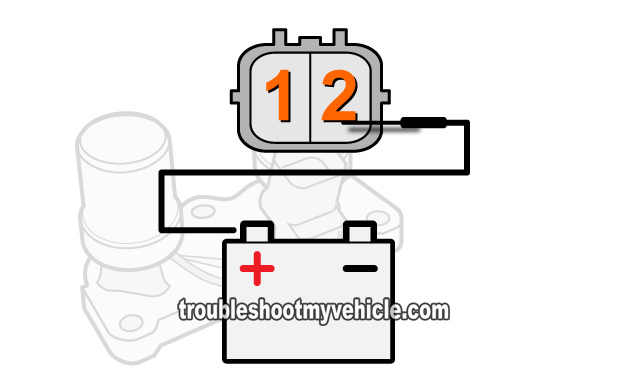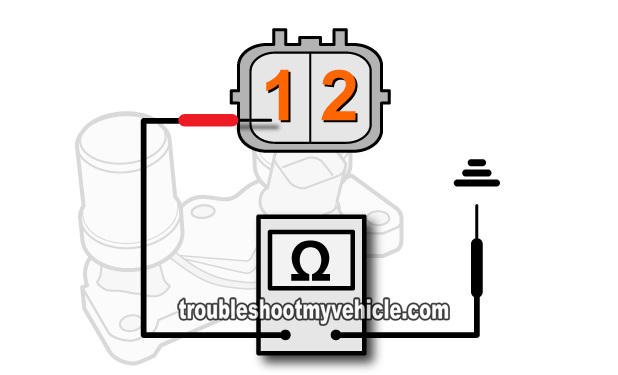
Testing the 1996-2000 1.6L Honda Civic automatic transmission's lock-up solenoid assembly is a whole lot easier than you think.
The two solenoid valves that make up the lock-up solenoid assembly are easily tested, and in this tutorial, I'm gonna' show you how in a step-by-step manner.
Contents of this tutorial:
APPLIES TO: This tutorial applies to the following vehicles:
- 1.6L Honda Civic DX: 1996, 1997, 1998, 1999, 2000.
- 1.6L Honda Civic EX: 1996, 1997, 1998, 1999, 2000.
- 1.6L Honda Civic LX: 1996, 1997, 1998, 1999, 2000.
SHIFT SOLENOID A AND B TESTS:
START HERE: Lock Up Solenoid Assembly Tests
As you're already aware, the lock-up solenoid assembly on your 1996-2000 1.6L Honda Civic is made up of two solenoids.
One is identified as solenoid valve “B” and the other is identified as solenoid valve “A”.
Troubleshooting both of them isn't hard since both are tested in the same way. There are two basic tests for each solenoid that makes up the pack.
Here's a brief description of the 4 tests in this tutorial:
- Resistance testing solenoid valve A..
- This test simply involves measuring the resistance of solenoid valve A and comparing the value with the factory spec of 14-25 Ohms.
- TEST 1: Shift Solenoid A Resistance Test.
- Manually applying 12 Volts to solenoid valve A.
- In this test, you'll use a jumper wire to apply power (from your Honda's battery) to shift solenoid A and listen for a clicking sound.
- TEST 2: Applying 12 V To Solenoid A.
- Resistance testing solenoid valve B.
- This test simply involves measuring the resistance of solenoid valve B and comparing the value with the factory spec of 14-25 Ohms.
- TEST 3: Solenoid B Resistance Test.
- Manually applying 12 Volts to solenoid valve B.
- In this test, you'll use a jumper wire to apply power (from your Honda's battery) to solenoid valve B and listen for a clicking sound.
- TEST 4: Applying 12 V To Solenoid B.
TEST 1: Solenoid A Resistance Test
Solenoid valve B, of the lock-up solenoid valve assembly, gets power on terminal labeled with the number 2 of its connector.
It gets Ground thru' its metal base (the one that bolts down to the transmission's case).
So, to test solenoid valve B's resistance with your multimeter, you'll need to probe terminal number 2 and the solenoid assembly's metal base.
If you don't have a multimeter and need to buy one, check out my recommendations here: Tekpower TP8268 AC/DC Auto/Manual Range Digital Multimeter (Amazon affiliate link).
NOTE: Perform this test with a completely cold engine/transmission to avoid getting your hands burned.
OK, this is what you need to do:
- 1
Place your multimeter in Ohms mode.
- 2
Unplug the lock up solenoid assembly from its electrical connector.
NOTE: This test is done on the lock-up solenoid's connector AND NOT on the engine wiring harness' connector. - 3
Measure the resistance between terminal labeled with the #2, in the image viewer above, and the solenoid assembly's body.
NOTE: Shift solenoid A is Grounded by the solenoid assembly's case. If the solenoid assembly is still bolted to the transmission housing, you can Ground your multimeter's lead directly on the battery's negative (-) terminal. - 4
Your multimeter should read 14-25 Ohms for the resistance value of shift solenoid A.
Let's take a look at what your test results mean:
CASE 1: Solenoid valve A's resistance is between 14-25 Ohms. This test result confirms that the solenoid's internal resistance is within the factory specification.
Although the shift solenoid A passed this test, there's still one more we need to do, which is to manually apply power to the solenoid and see if it clicks. Go to: TEST 2: Applying 12 V To Solenoid A.
CASE 2: Solenoid valve A's resistance WAS NOT between 14-25 Ohms. Recheck your multimeter test connections and retest. If you still don't get the correct resistance, then shift solenoid A is bad and you'll need to replace the entire lock-up solenoid valve assembly to solve the issue.
TEST 2: Applying 12 V To Solenoid A
After making sure that solenoid valve A's internal resistance is within 14 to 25 Ωs... The next step is to apply 12 Volts directly to it.
You're gonna' apply this voltage directly from your Honda Civic's battery.
IMPORTANT: Remember that the lock-up solenoid assembly gets Ground thru' its base, so if you perform this test with it removed from the transmission, you'll need to Ground the assembly to the battery negative (-) terminal using something like a jump-start cable.
These are the test steps:
- 1
Unplug the lock up solenoid assembly from its electrical connector.
NOTE: This test is done on the lock-up solenoid's connector AND NOT on the engine wiring harness' pigtail connector. - 2
Apply 12 Volts to terminal #2, of the lock-up solenoid assembly's connector, using a jumper wire or a power probe.
- 3
You should hear an audible click when the 12 Volts are applied.
Repeat this test as many times as you need to be certain of your test results.
CASE 1: Solenoid valve A clicked when you applied 12 Volts. This test result tells you that the solenoid is opening and closing.
Your next step is to test solenoid valve B. Go to: TEST 3: Solenoid B Resistance Test.
CASE 2: Solenoid valve A DID NOT click when you applied 12 Volts. This test result tells you that shift solenoid A is bad and needs to be replaced.
Since shift solenoid A is part of the lock-up solenoid assembly, you'll need to replace the entire assembly to solve the issue.
TEST 3: Solenoid B Resistance Test
Testing solenoid valve B, of your Honda Civic's lock-up solenoid assembly, involves 2 specific tests.
The first one, and the focus of this test section, is checking its internal resistance. The second test is applying battery voltage to it (and you'll do this in TEST 4).
Since the factory resistance specification is for the lock-up solenoid assembly at room temperature, you need to make sure that you Honda Civic's engine and transmission (and thus the lock-up solenoid assembly) is completely cold.
These are the test steps:
- 1
Place your multimeter in Ohms mode.
- 2
Unplug the lock up solenoid assembly from its electrical connector.
NOTE: This test is done on the lock-up solenoid's connector AND NOT on the engine wiring harness' pigtail connector. - 3
Measure the resistance between terminal labeled with the #1, in the image viewer above, and the solenoid assembly's body.
NOTE: The TCC lock-up solenoid is Grounded internally thru' the solenoid assembly's case. If the solenoid assembly is still bolted to the transmission housing, you can Ground your multimeter's lead directly on the battery's negative (-) terminal. - 4
The multimeter should register 14-25 Ohms for the resistance value of TCC lock-up solenoid.
Let's take a look at what your test results mean:
CASE 1: Solenoid valve B's resistance is between 14-25 Ohms. This is the correct and expected test result and generally means that the TCC lock-up solenoid is OK.
Although the TCC lock-up solenoid passed this test, there's still one more we need to do, which is to manually apply power to the solenoid and see if it clicks. Go to: TEST 4: Applying 12 V To Solenoid B.
CASE 2: Solenoid valve B's resistance WAS NOT between 14-25 Ohms. Recheck your multimeter test connections and retest. If you still don't get the correct resistance, then solenoid B, of the lock-up solenoid assembly, is bad.
Since solenoid valve B is part of the lock-up solenoid assembly, you'll need to replace the entire assembly to solve the issue.
TEST 4: Applying 12 V To Solenoid B
So far, you have checked that solenoid valve B, of the lock-up solenoid assembly, is within specification (14 to 25 Ωs)...
... The next step, and the last one, is to manually apply battery voltage to solenoid valve B and check that it makes a 'clicking' sound.
If the solenoid doesn't 'click', then the solenoid is fried and the whole lock-up solenoid assembly needs to be replaced.
IMPORTANT: Solenoid valve B gets Ground thru' the lock-up solenoid assembly's metal base, so if you do this test with it removed (from the transmission), you'll need to Ground the lock-up solenoid's base directly to your Honda Civic's negative battery terminal.
These are the test steps:
- 1
Unplug the lock up solenoid assembly from its electrical connector.
NOTE: This test is done on the lock-up solenoid's connector AND NOT on the engine wiring harness' pigtail connector. - 2
Apply 12 Volts to terminal #1, of the lock-up solenoid assembly's connector, using a jumper wire or a power probe.
- 3
You should hear an audible click when the 12 Volts are applied.
Repeat this test as many times as you need to be certain of your test results.
CASE 1: Solenoid valve B clicked when you applied battery power. This test result tells you that the solenoid is opening and closing and is operating like it should.
CASE 2: Solenoid valve B DID NOT click when you applied battery power. This test result tells you that solenoid B, of your Honda Civic's lock-up solenoid assembly, has failed.
Since solenoid valve B is part of the lock-up solenoid assembly, you'll need to replace the entire assembly to solve the problem.
Solenoid Assembly Is Good But Transmission Still Not Shifting

If you've tested and found either solenoid (solenoid valve A or B) good and your Honda's transmission isn't slipping yet a lock-up solenoid valve trouble code keeps popping up, I want to suggest two things:
- Remove the solenoid assembly and see if the metal mesh screen filters are clogged and if they are, you should clean them (see photo). Several people have reported that this has solved the issue.
- Check the continuity of the wires between the solenoid assembly and the PCM. You'll need a wiring diagram of your specific Honda to accomplish this test.
Also, and especially after finding no faults in the wiring, there's a good chance that you'll have to replace the lock-up solenoid assembly to completely eliminate it as the source of the problem. I know this isn't something you want to hear, but in some cases this is a necessary thing.
Now, if your Honda's transmission is slipping, then replacing the shift solenoid assembly isn't gonna' help bring the transmission back to normal. Slippage is a direct result of internal damage to the friction discs or hard parts. The only way to solve a slippage issue is overhauling the transmission.
More 1.6L Honda Civic Test Tutorials
If this tutorial was helpful, you can find a complete list of 1.6L Honda Civic diagnostic tutorials in this index:
Here's a sample of the tutorials you'll find there:
- How To Test For A Blown Head Gasket (1995-2000 1.6L Honda Civic).
- How To Test The Alternator (1996-2000 1.6L Honda Civic).
- Testing Shift Control Solenoid Valves A and B (1996-2000 1.6L Honda Civic).
- How To Troubleshoot A No Start (1995-2000 1.6L Honda Civic).
- How To Test The Igniter, Ignition Coil Accord, Civic, CRV, and Odyssey (at: easyautodiagnostics.com).

If this info saved the day, buy me a beer!







